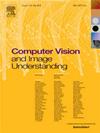利用三维事件表征探索基于事件的人体姿态估计
IF 3.5
3区 计算机科学
Q2 COMPUTER SCIENCE, ARTIFICIAL INTELLIGENCE
引用次数: 0
摘要
人体姿态估计是计算机视觉中一项基本而有吸引力的任务。虽然传统相机得到了普遍应用,但在高动态范围或严重运动模糊的情况下,其可靠性会降低,而事件相机则提供了一种稳健的解决方案。基于事件的主流方法将事件累积成帧,忽略了对区分不同动作至关重要的异步和高时间分辨率。为了解决这一问题并释放事件信息的三维潜力,我们引入了两种三维事件表示法:光栅化事件点云(RasEPC)和解耦事件体素(DEV)。RasEPC 将事件聚集在相同位置的简明时间切片中,保留了事件的三维属性和统计信息,从而大大降低了内存和计算需求。同时,DEV 表示法将事件离散化为体素,并将它们投射到三个正交平面上,利用解耦事件注意力从二维平面上检索三维线索。此外,我们还开发并发布了 EV-3DPW,这是一个基于事件的合成数据集,便于在室外场景中进行训练和定量分析。我们的方法在 DHP19 公开数据集、MMHPSD 数据集和 EV-3DPW 数据集上进行了测试,并通过衍生驾驶场景数据集 EV-JAAD 和室外采集车辆进行了进一步的定性验证。我们的代码和数据集已在 https://github.com/MasterHow/EventPointPose 上公开发布。本文章由计算机程序翻译,如有差异,请以英文原文为准。
Exploring event-based human pose estimation with 3D event representations
Human pose estimation is a fundamental and appealing task in computer vision. Although traditional cameras are commonly applied, their reliability decreases in scenarios under high dynamic range or heavy motion blur, where event cameras offer a robust solution. Predominant event-based methods accumulate events into frames, ignoring the asynchronous and high temporal resolution that is crucial for distinguishing distinct actions. To address this issue and to unlock the 3D potential of event information, we introduce two 3D event representations: the Rasterized Event Point Cloud (RasEPC) and the Decoupled Event Voxel (DEV). The RasEPC aggregates events within concise temporal slices at identical positions, preserving their 3D attributes along with statistical information, thereby significantly reducing memory and computational demands. Meanwhile, the DEV representation discretizes events into voxels and projects them across three orthogonal planes, utilizing decoupled event attention to retrieve 3D cues from the 2D planes. Furthermore, we develop and release EV-3DPW, a synthetic event-based dataset crafted to facilitate training and quantitative analysis in outdoor scenes. Our methods are tested on the DHP19 public dataset, MMHPSD dataset, and our EV-3DPW dataset, with further qualitative validation via a derived driving scene dataset EV-JAAD and an outdoor collection vehicle. Our code and dataset have been made publicly available at https://github.com/MasterHow/EventPointPose.
求助全文
通过发布文献求助,成功后即可免费获取论文全文。
去求助
来源期刊

Computer Vision and Image Understanding
工程技术-工程:电子与电气
CiteScore
7.80
自引率
4.40%
发文量
112
审稿时长
79 days
期刊介绍:
The central focus of this journal is the computer analysis of pictorial information. Computer Vision and Image Understanding publishes papers covering all aspects of image analysis from the low-level, iconic processes of early vision to the high-level, symbolic processes of recognition and interpretation. A wide range of topics in the image understanding area is covered, including papers offering insights that differ from predominant views.
Research Areas Include:
• Theory
• Early vision
• Data structures and representations
• Shape
• Range
• Motion
• Matching and recognition
• Architecture and languages
• Vision systems
 求助内容:
求助内容: 应助结果提醒方式:
应助结果提醒方式:


